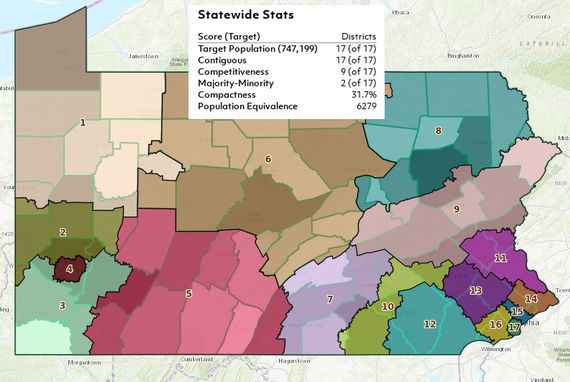Team CCAC-South, Honorable Mention, Adult-West

Team CCAC-South consists of Dean Jolin (bottom left), Kelli Maxwell (bottom right), Darren Lesher (top left), Steven Shaulis (top right), all of whom work at the Community College of Allegheny County's south campus. (Bios and photos requested.)
Judges' statement
The team entry lead by Dean Jolin provided a strong and heartfelt personal statement based on their experiences as educators and the discussions they had with their students. We truly appreciated their focus on drawing a map that would in some way address the issues they see affecting their students every day. The range of challenges that were discussed and overcome through this group entry exemplified the community-based approach to mapping voting districts.

Personal statement
Our team is made up of four administrators at the Community College of Allegheny County (CCAC), a public-serving institution committed to providing resources to a diverse population of students. Given the high number of at-risk students we serve, particularly those in minority groups and of low socioeconomic status, we decided as a team it was imperative for us to take part in Draw the Lines.
Ultimately, our aim as higher education professionals is to ensure our students have a voice, a family-sustaining wage, and equitable representation in the political landscape.
As our map developed, the complexity of district determination became apparent. We brainstormed for hours across many weeks before narrowing to the following priorities for districting:
- Minimizing the number of unrepresented individuals in the population.
- Reducing the spread of areas surrounding densely populated cities such as Pittsburgh and Philadelphia to ensure these areas cannot limit the voice of people in more rural areas
- Ensuring lines did not split other major cities including Reading, York, Harrisburg, and State College.
The team was keen on seeking input to approach drawing district lines from a variety of perspectives and ensure equal representation of all voices. The team started as one individual at the college, but interest quickly grew as other members of the Student Development team saw an opportunity to carry the work of student support and development to a larger scale.
The team experienced a number of challenges in developing the map. Some were overcome more easily than others, while some issues remained barriers throughout the map's creation. Obstacles included:
- Meeting the target population for each district. The group overcame this by making small tweaks to work towards the target 747,199, but maintained the aforementioned priorities as crucial to the goal of drawing lines focused on equitable representation of diverse voices.
- Ensuring representation of all voices in sparsely populated, rural areas (particularly in the northern and central parts of the state). This barrier caused the group to prioritize avoiding the split of major cities such as State College to ensure more densely populated pockets within these rural areas did not overrun voices of the district as a whole.
The Draw the Lines initiative has certainly made an impact on our team and increased our awareness around the issues of redistricting in the state of Pennsylvania. It is our team's hope that redistricting at the legislative level will adopt these same principles while using their resources to overcome the challenges we encountered.